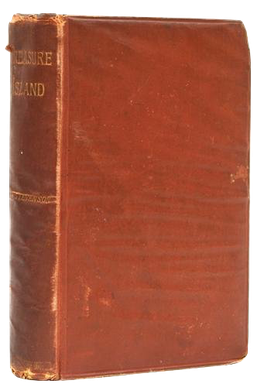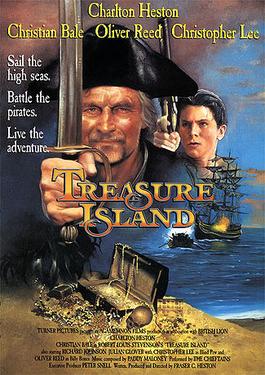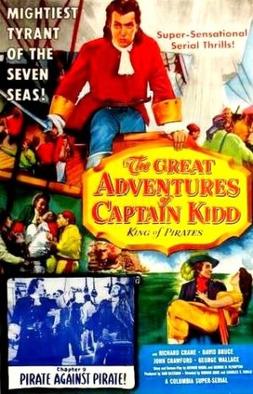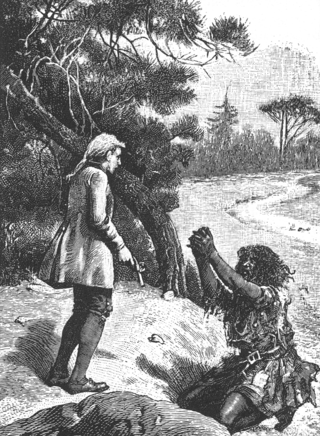
William Kidd also known as Captain William Kidd or simply Captain Kidd, was a Scottish privateer. Conflicting accounts exist regarding his early life, but he was likely born in Dundee and later settled in New York City. By 1690, Kidd had become a highly successful privateer, commissioned to protect English interests in North America and the West Indies.

Treasure is a concentration of wealth — often originating from ancient history — that is considered lost and/or forgotten until rediscovered. Some jurisdictions legally define what constitutes treasure, such as in the British Treasure Act 1996.

Treasure Island is an adventure novel by Scottish author Robert Louis Stevenson, telling a story of "buccaneers and buried gold". It is considered a coming-of-age story and is noted for its atmosphere, characters, and action.

El Dorado is commonly associated with the legend of a gold city, kingdom, or empire purportedly located somewhere in the Americas. Originally, El Hombre Dorado or El Rey Dorado, was the term used by the Spanish in the 16th century to describe a mythical tribal chief (zipa) or king of the Muisca people, an indigenous people of the Altiplano Cundiboyacense of Colombia, who as an initiation rite, covered himself with gold dust and submerged himself in Lake Guatavita.

Buried treasure is a literary trope commonly associated with depictions of pirates, alongside Vikings, criminals, and Old West outlaws. According to popular conception, these people often buried their stolen fortunes in remote places, intending to return to them later.

The Copper Scroll (3Q15) is one of the Dead Sea Scrolls found in Cave 3 near Khirbet Qumran, but differs significantly from the others. Whereas the other scrolls are written on parchment or papyrus, this scroll is written on metal: copper mixed with about 1 percent tin, although no metallic copper remained in the strips; the action of the centuries had been to convert the metal into brittle oxide. The so-called 'scrolls' of copper were, in reality, two separated sections of what was originally a single scroll about 2.4 metres (7.9 ft) in length. Unlike the others, it is not a literary work, but a list of 64 places where various items of gold and silver were buried or hidden. It differs from the other scrolls in its Hebrew, its orthography, palaeography and date.

Captain J. Flint is a fictional golden age pirate captain who features in a number of novels, television series, and films. The original character was created by the Scottish writer Robert Louis Stevenson (1850–1894). Flint first appears in the classic adventure yarn Treasure Island, which was first serialised in a children's magazine in 1881, and later published as a novel in 1883.

Treasure Island is a 1934 film directed by Victor Fleming and starring Wallace Beery, Jackie Cooper, Lionel Barrymore, Lewis Stone, and Nigel Bruce. It is an adaptation of Robert Louis Stevenson's famous 1883 novel of the same name. Jim Hawkins discovers a treasure map and travels on a sailing ship to a remote island, but pirates led by Long John Silver threaten to take away the honest seafarers’ riches and lives.

In English-speaking popular culture, the modern pirate stereotype owes its attributes mostly to the imagined tradition of the 18th-century Caribbean pirate sailing off the Spanish Main and to such celebrated 20th-century depictions as Captain Hook and his crew in the theatrical and film versions of J. M. Barrie's children's book Peter Pan, Robert Newton's portrayal of Long John Silver in the 1950 film adaptation of the Robert Louis Stevenson novel Treasure Island, and various adaptations of the Middle Eastern pirate, Sinbad the Sailor. In these and countless other books, films, and legends, pirates are portrayed as "swashbucklers" and "plunderers". They are shown on ships, often wearing eyepatches or peg legs, having a parrot perched on their shoulder, speaking in a West Country accent, and saying phrases like "Arr, matey" and "Avast, me hearty". Pirates have retained their image through pirate-themed tourist attractions, film, toys, books and plays.

Treasure Island is a 1990 British-American made-for-television film adaptation of Robert Louis Stevenson’s 1883 novel of the same name, written and directed by Fraser Clarke Heston, and also starring several notable British actors, including Christian Bale, Oliver Reed, Christopher Lee, Julian Glover and Pete Postlethwaite.

Piracy in the British Virgin Islands was prevalent during the so-called "Golden Age of Piracy", mainly during the years of 1690-1730. Privateering was also widely practised in the jurisdiction throughout frequent colonial wars, not least by emancipated slaves who, with in preference to back-breaking labour in the fields for pitiful wages, took enormous risks to capture fortunes on the seas with the sanction of the Crown. In 1808, Patrick Colquhoun, a prize agent for the Territory spoke of "the most daring outrages which are frequently committed by people of colour."

Billy Bones is a fictional character appearing in the first section of Robert Louis Stevenson's 1883 novel Treasure Island.

Dr. David Livesey is a fictional character from the 1883 novel Treasure Island by Robert Louis Stevenson. As well as doctor, he is a magistrate, an important man in the rural society of southwest England, where the story opens; his social position is marked by his always wearing a white wig—even in the harsh conditions of the island on which the adventure takes place.

The Great Adventures of Captain Kidd (1953) was the 52nd serial released by Columbia Pictures. It is based in the historical figure of Captain William Kidd.

Frederick Graham, who writes under the name Cork Graham, is an American author of adventure memoir and political thriller fiction novels. He is a former combat photographer, who was imprisoned in Vietnam for illegally entering the country while supposedly looking for treasure buried by Captain Kidd.

Treasure Island is a 1920 silent film adaptation of the 1883 novel by Robert Louis Stevenson, directed by Maurice Tourneur, and released by Paramount Pictures. Lon Chaney played two different pirate roles in this production, "Blind Pew" and "Merry", and stills exist showing him in both makeups. Charles Ogle, who had played Frankenstein's Monster in the first filmed version of Frankenstein a decade earlier at Edison Studios, portrayed Long John Silver. Wallace Beery was supposed to play Israel Hands, but that role went to Joseph Singleton instead. The film was chosen as one of the Top Forty Pictures of the Year by the National Board of Review.

Benjamin "Ben" Gunn is a fictional character in the 1883 novel Treasure Island by Scottish author Robert Louis Stevenson.

Jim Hawkins is a fictional character and the protagonist in Robert Louis Stevenson's 1883 novel Treasure Island. He is both the protagonist and main narrator of the story.

Treasure Island is a 1918 American silent adventure film based on the 1883 novel of the same name by Robert Louis Stevenson. This is one of many silent versions of the story and is noteworthy because it is almost entirely acted by child or teenage actors. The film was co-directed by brothers Sidney and Chester Franklin. The film is one of Fox's Sunset Kiddies productions following in the wake of previous Kiddie productions like Aladdin and his Wonderful Lamp. This is a lost film.

Raleigh's El Dorado expedition, also known as Raleigh's first voyage to Guiana, was an English military and exploratory expedition led by Sir Walter Raleigh that took place during the Anglo-Spanish War in 1595. The expedition set out in February 1595 to explore the Orinoco River on the northeast tip of South America in an attempt to find the fabled city of El Dorado.






















